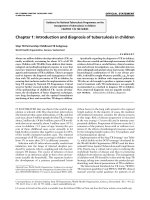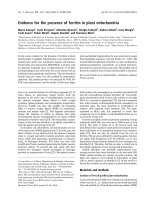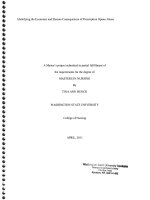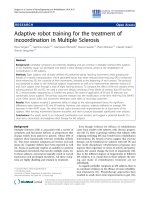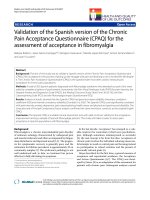Lung ultra for the diagnosis of pneumonia in children a meta analysis
Bạn đang xem bản rút gọn của tài liệu. Xem và tải ngay bản đầy đủ của tài liệu tại đây (442.45 KB, 16 trang )
LUNG ULTRASOUND FOR THE DIAGNOSIS OF
PNEUMONIA IN CHILDREN: A META ANALYSIS
PEDIATRICS Volume 135, number 4, April 2015
Maria A. Pereda, MD,
Miguel A. Chavez, MD,
Catherine C. Hooper-Miele, MD ,
Robert H. Gilman, MD, DTMH,
Mark C. Steinhoff, MD,
Laura E. Ellington, MD,
Margaret Gross, MA, MLIS,
Carrie Price, MLS,
James M. Tielsch, PhD,
William Checkley, MD, PhD
BS NGUYỄN TRỌNG LINH
1
KHOA NỘI 1
1.INTRODUCTION:
Pneumonia is the leading cause of illness & death
of children (# a global annual incidence of 150 156 million cases in children <5 years of age, ∼11
- 20 million of cases need hospitalization & 1.1
million die of this condition).
Pneumonia accounts for 18% of the total number
of deaths in children <5 years worldwide, more
than tuberculosis, AIDS, malaria combined.
2
Diagnostic tools include chest radiography CRs,
still remains a challenge in resource-limited
settings.
The AAP recommends the use of CRs cautiously:
- potential late adverse effects of ionizing radiation
- the lack of findings on CR does not rule out the
diagnosis.
- a chest CT scan almost never used for the
diagnosis of pneumonia because of higher ionizing
radiation exposure, difficulty in patient
cooperation, cost.
Other disadvantages: availability & portability, a
considerable time delay & a final reading.
3
Advances in ultrasound technology have made
lung ultrasound (LUS) an attractive option for
the diagnosis of pneumonia. Moreover,
ultrasound is safe, portable, inexpensive, and
relatively easy to teach.
We conducted a meta-analysis to summarize
evidence on the diagnostic accuracy of LUS for
childhood pneumonia.
4
2.METHODS:
2.1. Search methods:
A systematic literature search was applied to:
PubMed (1946 present)
Embase (1974 now)
The Cochrane Library (1898 now)
Scopus (1966 now)
Global Health (1973 now)
Wolrd Health Organization Global Health Regional
libraries (1980 now)
Latin American and Caribbean Health Sciences Literature
(1980 now)
Key words: <18 years, pneumonia,
ultrasound
5
2.2. Study Eligibility:
Children with clinical suspicion (signs and
symptoms) of pneumonia and/or confirmation
with CR or chest CT scan.
-The evaluation of pneumonia was based on a
combination of clinical data, laboratory results,
and chest imaging by CR or chest CT scan
6
2.2.Data Extraction:
-Sample size,
-gender proportion,
-mean age,
-LUS technique,
-areas of the chest that were evaluated,
-time lapse between CR and LUS, average time to
perform LUS,
-operator expertise,
-blinding,
-LUS pattern definitions,
-and number of true-positives, true-negatives, falsepositives, and false-negatives.
7
2.3.Methodologic Quality Assessment
and Biostatistical Methods:
Methodologic quality was assessed by using the
QUADAS -2 critetion
Biostatistical methods: The primary objective =
estimate pooled measurements of diagnostic
accuracy
Pooled sensitivity and specificity: Mantel-Haenszel
method
Pooled positive and negative likelihood ratios (LRs):
DerSimonian-Laird method
Heterogeneity: the Cochran Q-statistic and the
inconsistency (I2) test
Statistical analyses: Meta-DiSc 1.4 and R
8
3.RESULTS:
-In 1475 studies, we selected 8 studies for analysis
(6 conducted in the general pediatric population &
2 conducted in neonates).
-5 studies conducted in Italy, 1 in USA, 1 in China &
1 in Egypt
9
-3 studies were conducted in emergency
departments, 2 in hospital wards, 1 in the pediatric
ICU, and 2 in the neonatal ICU.
-Overall, there were 765 children. The mean age: 5
years (range: 0–17 years) and 52% were boys.
-5 studies (63%): a highly skilled physician performed
LUS,
10
3.1.Methodologic Heterogeneity:
The quality of most of the studies: high. 7 studies (88%)
enrolled patients who would have had a CR as part of usual
clinical practice. Only 1 (12%) study included controls who
did not have CRs.
All studies conducted LUS immediately after chest imaging
was obtained.
1 (12%) study used the same radiologist to read both the CR
and LUS.
7 (88%) studies assessed LUS results independently and
were blinded to CR results.
11
3.1.Methodologic Heterogeneity:
LUS sonographers were not blinded to clinical data.
Furthermore, 5 (63%) studies used clinical criteria and CR as a
diagnosis standard and 3 included laboratory results as additional
diagnostic tools.
3 studies (38%) used chest CT scan for clinical purposes.
All of the studies used a linear probe , with frequencies ranging from 6
to 12 MHz. In addition, a convex probe with frequencies ranging from
2 to 6.6 MHz was used in conjunction with the linear probe in 3 of the
8 studies.
12
3.2.Overall Meta-analysis:
-LUS had a sensitivity of 96% (95% confidence interval [CI]:
94%–97%) and specificity of 93% (95% CI: 90%–96%), and
-positive and negative likelihood ratios were 15.3 (95% CI:
6.6–35.3) and 0.06 (95% CI: 0.03–0.11), respectively.
-The area under the receiver operating characteristic curve
was 0.98.
13
3.3.Subgroup Analyses:
In the 6 studies (75%) (excluding neonates), LUS had a
sensitivity of 96% (93%–98%) - a specificity of 92% (88%–
95%); and in the 2 studies (only neonates), LUS had a
sensitivity of 96% (90%–98.5%) - a specificity of 100%
(92%–100%).
3 studies were conducted in emergency departments:
sensitivity of 94% (88%–98%) and specificity of 90%
(85%–94%). Studies conducted in hospital settings other
than in an emergency department had a combined
sensitivity of 96% (94%–98%) and a specificity of 97%
(93%–99%)
4 studies that used emergency department physicians,
general practitioners, residents, or health care
professionals otherwise not specified, LUS had a pooled
sensitivity of 95% (95% CI: 91%–97%) and aspecificity of
91% (87%–95%).
14
4.Limitations:
The total number of studies was small, a low number
of patients, there was significant heterogeneity
between studies.
Second, not all studies compared LUS results with a
clinical diagnosis and, in some studies, the final
diagnosis was based solely on CR findings without the
influence of clinical data.
15
5.CONCLUSION:
Current evidence supports LUS as an imaging
alternative for the diagnosis of childhood
pneumonia.
Recommendations to train pediatricians on
LUS for diagnosis of pneumonia may have
important implications in different clinical
settings.
16


